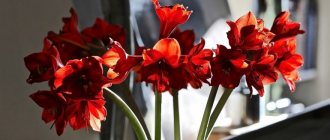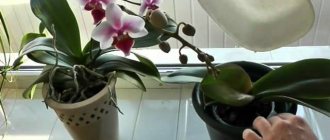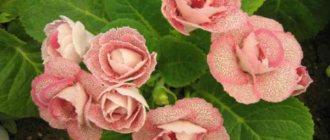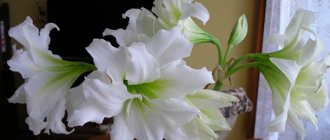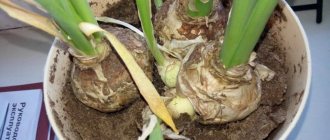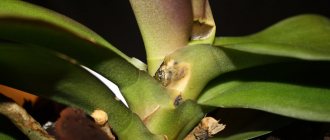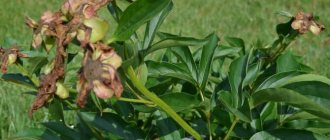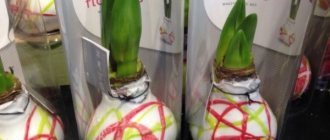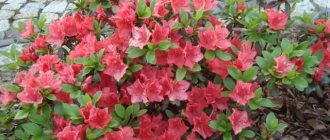Author: Elena N. https://floristics.info/ru/index.php?option=com_contact&view=contact&id=19 Category: Houseplants Published: February 21, 2019Last edits: January 11, 2021
Most of the beautifully flowering plants, after their flowering is complete, go into a dormant state. Plants need rest to restore the energy spent on flower formation and to lay flower buds for the next flowering. Bulbous crops such as amaryllis (hippeastrum) are no exception in this regard. There is a certain procedure for introducing bulbous plants during the dormant period. From our article you will learn:
- how to prepare amaryllis for the dormant period;
- how to cover bulbs overwintering in the ground;
- when to remove bulbs from the ground for the winter;
- how to store bulbs until new planting.
Preparing amaryllis for the dormant period
The dormant period for amaryllis is the end of autumn and the beginning of winter. For hippeastrums, the dormant period begins after the plant has flowered, because hippeastrums can be driven out at any time of the year, and not just at the end of summer or early autumn. Early forcing in autumn or late is possible - then the hippeastrum blooms at the end of winter or beginning of spring. Some varieties bloom even in summer.
But whenever your amaryllis or hippeastrum blooms, it needs a period of rest. So far, only one evergreen species of hippeastrum is known - Hippeastrum Papilio, for which there is no need for a dormant period. The remaining varieties of amaryllis and hippeastrum should rest. If you planted amaryllis or hippeastrum in the ground for the summer, then you need to dig its bulb out of the ground before frost and store it in a cool, dark, dry place.
- Violets: how to get many cuttings from one leaf
Amaryllis propagation
Amaryllis reproduces by seed and vegetative methods - by children. When growing amaryllis from flower seeds, you will wait no earlier than seven years; in addition, to obtain seed material, you will have to pollinate the amaryllis with a brush, transferring pollen from the stamens to the pistil, then wait until the seeds ripen, collect them, and sow them in loose, moist soil. substrate and grow in a warm and bright place. If you love experiments and are not afraid of difficulties, then this job is for you.
It is much easier to propagate amaryllis with the help of children, which are formed with healthy, strong bulbs. Children reveal themselves by releasing long leaves. You can separate them from the bulb when replanting, or you can dig them up, filling the resulting void in the pot with soil. The children are kept for half an hour in a pink solution of potassium permanganate and seated in small glasses for rooting. As the children grow, they are transplanted into larger dishes. Amaryllis from daughter bulbs will bloom in five years. And remember: if you want to get a strong bulb and a large peduncle, do not let the plant bloom for the first time.
Leaves are a source of nutrients
However, the amaryllis bulb is not immediately dug up after flowering; you must first allow the leaves to do the important job of supplying the bulb with nutrients.
In the period preceding dormancy, it is necessary to prepare the bulb and give it the opportunity to recover after flowering. The leaves should dry naturally, giving all their strength to the bulb. From mid-September, the frequency of watering amaryllis (or hippeastrum) is reduced. Once the leaves have completely yellowed and died, the plant will go dormant on its own.
Signs and superstitions
There are several interesting signs and superstitions associated with this exotic plant:
- There is a sign that a flower makes a wish come true. When buying an unblown amaryllis, make a wish so that no one knows about it. If the plant blooms in the first season, then the dream will come true.
- This exotic beauty is under the protection of the element of Fire and brings happiness and joy to the house. However, it should not be placed in the most visible place, or in the bedroom. It is better to place the pot in the kitchen.
- Amaryllis is not “friendly” with other indoor plants, so it is used only in single compositions.
- The poisonous juice of amaryllis is considered medicinal and is used in folk medicine of the indigenous peoples of South Africa.
When growing amaryllis, remember that it is incompatible with other indoor plants, but will serve as a bright accent for decorating a desktop or kitchen window sill. The amaryllis flower does not require much attention and, with proper care at home, pleases its owner with regular and lush flowering.
Wintering amaryllis and hippeastrum
The main dormant period for amaryllis is 2-3 autumn months. If the plant was planted in open ground for the summer, then after flowering the amaryllis must be dug up and replanted in a pot before frost.
Hippeastrum can be left in the ground for the winter. In general, it is enough to replant these flowers once every 3-4 years. And in order for the hippeastrum in the garden to easily withstand frost, it must be covered with a dense layer of peat or other mulch.
But if you decide to take the hippeastrum indoors for the winter, the main thing is to provide its bulb with a cool temperature within 10-18°C.
The nuances of flower growth in the cold season
The plant belongs to the perennial herbaceous bulbous species. In the wild, its stems reach towards the sun in South Africa and Australia.
Amaryllis is a fairly unpretentious bulbous plant that usually blooms in spring. At first, the culture, which is also called hippeastrum, produces in turn several large peduncles with equally large flowers. After this, the growth of green mass in the form of powerful leaves begins. However, after a certain time, the foliage turns pale and gradually fades. This indicates the onset of a period of long rest.
Starting from approximately the middle of the first autumn month and until spring, the flower continues its dormant period. The plant needs to regain its strength after the active growing season. By that time, the growth of stems and flowering stops. Having thrown off the existing powerful foliage, the plant begins to prepare for the cold period.
For almost six months, the hippeastrum restores its strength after flowering and prepares for the growing season in the next season, and all this happens in the winter season. In anticipation of cold weather, amaryllis is not watered, and the bulbs removed from the soil are stored in a dark, cool room.
Anyone who knows how to care for a plant leaves it in the garden on the ground all winter. In order for the bulbs to easily withstand the January cold, they need to be covered with a dense layer of upper neutral peat or other covering material.
Preparing for rest
By looking closely at the shoots, you can easily understand that the flower is preparing for winter hibernation. The process is characterized by wilting and loss of intense leaf color. The accumulated organic matter is transferred to the foliage of the bulb, creating an essential nutrient resource. However, the gardener should not rush to trim yellowing leaves; he must wait until they fall naturally.
The procedure for preparing for hibernation is as follows:
- At the end of August, crop irrigation is gradually reduced to a minimum value, and any fertilizing is also canceled. Yellow and wilted foliage should be trimmed carefully, as close to the bulb as possible.
- You should carefully inspect the bulb and, if necessary, remove its dead particles, the remains of the dried root ball and the soil remaining on it. Healthy underground plant shoots should be free of signs of rot, mold and cracks. Sick poppies and those affected by garden pests are isolated from healthy ones.
- Selected amaryllis, cared for in winter, is subject to disinfection, which is expressed by keeping it in a weak potassium permanganate brine for half an hour. This procedure will prevent the development of infectious diseases. An additional precaution would be to wrap the domes with a clean napkin or toilet paper.
- Future planting material should be placed in a cool, dark place. This could be a basement or cellar. If the plant was in a pot, it must be freed from soil for mandatory ventilation. However, the crop is not famous for its frost resistance, so low temperatures mean death for them.
- In such conditions, the bulbs are stored until the last month of winter, when they can be transferred to open ground.
- During wintering, the crowns should be periodically subjected to a kind of inspection, identifying bulbs that did not survive until warm days.
After the flower shoot appears, the bulb should be watered and transferred to the site.
Amaryllis bulb contains lycopene. The alkaloid manifests itself as a toxic effect on the human body, followed by poisoning. Therefore, all agrotechnical activities with poppies are carried out wearing protective gloves.
Temperature
When at rest, amaryllis and hippeastrum bulbs should be kept in a cool room. It is best if the temperature is about 15°C, but a temperature of 10°C is also considered acceptable, and the upper value is 18°C. If it is cooler, the bulb may hurt, and if it drops below 5°C, it may die.
- Zephyranthes
Therefore, if you live in an area where the soil freezes below 5°C in winter, it is better to dig up the bulbs for the winter. This is especially true for amaryllis. A higher temperature than 18ºC during the dormant period may cause the bulb to germinate too quickly.
This is also not very good, since the plant did not have time to rest, and it is complete rest that guarantees the establishment of a healthy flower arrow.
During dormancy, you only need to water the bulb so that it does not dry out - once every month and a half. Moreover, water must be poured into the pan so that in conditions of cool air and excess water the bulb does not rot.
You will know that the recuperation period is over when a flower shoot appears on the amaryllis bulb. But active watering and fertilizing should begin only after this arrow extends to 10 cm. From this moment a new growth cycle of amaryllis or hippeastrum begins. Now you need to learn how to care for amaryllis at home and in the garden, depending on where it will grow.
Control of parasites
During periodic inspections of the bulbs, it may be discovered that they have begun to be affected by some parasites, fungus, or insect pests have reached the bulbs. In this case, it is strongly recommended that you do the following:
- First of all, it is necessary to isolate damaged specimens of amaryllis bulbs from undamaged ones so that the fungus or infection does not spread to the latter.
- Bulbs damaged by the pest should be brought into a warm room and treated a second time with a mild manganese solution or with specialized products intended for disinfecting bulbous plants.
- After treatment with such disinfectants, it is imperative to allow the bulbs to dry thoroughly.
- To re-wrap treated amaryllis bulbs, you should never use the same paper in which they were previously wrapped. You should take fresh, clean napkins or clean layers of toilet paper.
- After all the preparations have been carried out, the amaryllis bulbs should be sent back for storage in a dark and cool room.
Read more about why amaryllis leaves turn yellow, pests and fungal diseases appear, as well as how to cure a flower.
We recommend that you read our other articles:
- How should you make bouquets with amaryllis and for what celebrations is it appropriate?
- What are the most popular and cheapest varieties of amaryllis?
- What is the difference between amaryllis and hippeastrum?
- What does amaryllis look like? Flower structure.
- When and how does Amaryllis Belladonna bloom? Poisonous or not? How to care?
Amaryllis are not only a model of beauty among flowers of this kind, but also a very, very unpretentious and easy-to-care plant. If properly maintained in winter conditions, a bulb planted in a flower pot in mid-February will be able to please its owner with extraordinary beautiful blooms by the end of March.
How to get a flower after dormancy at home?
Often, after resting, the bulb wakes up on its own - the first tender shoots hatch. If a flower is sleeping, its awakening needs to be stimulated :
- The bulbs are dipped for 20-30 minutes in a weak solution of manganese or in a fungicide solution to treat the tubers (flower growers use the universal drug Maxim).
- Inspect the bulbs after resting - the tuber should be hard, elastic, without rot, the bottom should be clean, light brown in color.
- Trim dry and rotten shoots, clean off all brown scales (after soaking they clean well).
- Dry it, dust all cut areas with wood ash for disinfection.
- Pour the prepared soil mixture almost to the top of the pot.
- Carefully place the tuber in the center in a small depression, while straightening out the fragile root shoots.
- Press the bulbs a little, deepening them by 1/3 -1/4 of the entire growth, but no more than 2/3.
Care for starting and stimulating flowering:
- The pots are placed in a warm, bright place.
- The daytime temperature range is 20-22°C, night differences are not lower than 18-19°C.
- The seedlings are not watered until a peduncle of 2-3 cm appears (watering stimulates leaf growth).
- The first waterings are moderate, until the flower shoot gets stronger and begins to grow.
- Fertilizing is applied during the period of active growth and flowering 2 times a month.
- It is recommended to alternate organic matter (a solution of mullein or bird droppings) with mineral complexes, and feed with a mixture of magnesium sulfate, ammonium nitrate, potassium salt and superphosphate in a ratio of 1:1:3:2.
Prepare the substrate yourself or use a purchased universal soil mixture for bulbous plants with the addition of perlite, ash and superphosphate.
Proportions of substrate to stimulate growth and forcing of peduncles:
- turf land - 1 part;
- leaf soil - 1 part;
- humus - 2 parts;
- coarse river sand – 1/4 – 1/2 part;
- sand is replaced with perlite or vermiculite;
- bone meal or wood ash – up to 2 tbsp. l.;
- superphosphate – 1-2 tsp;
- The soil is mixed and moistened with a spray bottle.
Planting containers:
- small pot, about the size of an onion;
- norm - from the edge of the container to the bulb - 1.5-2 cm;
- Drainage is required at the bottom (expanded clay or crushed stone).
Diseases and pests
Amaryllis can be susceptible to pests and various diseases, especially fungal ones. It is worth considering the most dangerous diseases for African flowers.
Stagonosporosis (red burn)
Signs: red spots on the bulb and shoots. Causes: waterlogging, hypothermia or a sudden change in temperature. Treatment: the disease is serious, the flower may die from it, so treatment should consist of the following steps:
- it is necessary to remove the plant from other indoor inhabitants, since this fungus is contagious;
- then all damaged areas should be removed, but before that you can place the plant in a solution of potassium permanganate for 1 hour;
- Next, take the amaryllis out into the fresh air and dry for 1 week;
- we treat the flower with a disinfectant, for example, “Fundazol”;
- We minimize watering.
Anthracnose
Signs: the leaves become covered with dark brown spots surrounded by a purple border, and then begin to dry out. If the plant is not treated, it will die. Treatment includes the following:
- cut off parts of the plant damaged by the fungus;
- treat the flower with “Fungicide” or another antifungal drug;
- reduce the frequency of watering.
Gray rot
Signs: gray-brown spots on the leaves and bulb, rotting of the plant, accompanied by an unpleasant odor. Reason: too much watering or hypothermia of the soil. Treatment is as follows:
- dig up an onion;
- remove damaged areas;
- spray the plant with “Fundazol” or treat it with brilliant green;
- leave to dry for 2 days;
- transplant it into another pot on new soil.
Fusarium (root rot)
Signs: damage to the roots causes the plant to dry out and wither. Reasons: sudden change in temperature or lack of nutrients in the soil. Treatment consists of the following:
- isolate from other plants so that they do not become infected;
- dig up the bulb and treat it with “Fundazol” or other insecticidal preparations;
- It is advisable to transplant the plant into new soil.
It is worth considering the pests that most often attack amaryllis.
Thrips are small brown bugs that settle on leaves and look like black dots. As a result of their vital activity, silvery-white areas appear on the leaf, and then it begins to turn yellow and dry. The plant “infested” with thrips must be washed with warm water, then replanted on new soil and treated with “Fitoverm” or another insecticidal agent.
Spider mite - its presence can be determined by its characteristic feature: a white cobweb on the leaves, which provokes the gradual withering of the plant. To get rid of spider mites, you need to spray the shoots with any insecticide, for example, “Kleschevit”, “Neoron” or “Oberon”.
The onion mite greatly damages parts of the plant, especially the bulb, which is why it begins to rot and crumble, the leaves turn yellow and fall off, and the growth of the plant stops. Insecticides that contain phosphorus are harmful to this pest.
The amaryllis bug infects the plant bulb, causing the leaf formation process to completely stop. You can cure the plant by cutting off all damaged areas and treating it with any insecticide. It is advisable not to be limited to the one-time procedure, but to carry out insecticidal sprayings throughout the month.
Aphids are small insects that suck nutritious juices from a plant, causing its leaves to turn yellow and curl. You can destroy aphids by wiping the leaf part with a sponge dipped in a soap solution.
Amaryllis will become a real “diamond” in your collection of indoor plants and every year will delight your household and guests with luxurious flowers and exquisite aroma.
Tips for caring for amyrillis at home in the video below.
Forum of flower growers Frau Flora
About growing indoor and garden plants, discussion of species, varieties, diseases, pests.
How to stimulate hippeastrum flowering
Moderator: JanaS
How to stimulate hippeastrum flowering
Post by Yavia » 08 Apr 2015, 10:43
Nadya, your hippeastrum has problems with its roots. Most likely they are missing.
MAK, Marina, you cannot force hippeastrum to bloom. As Lena already wrote in a previous message, the flower arrow is formed a year or two before the expected flowering. Plants purchased last year may skip a year, but not always. Remember that these are forced plants, they have already flourished and fulfilled their purpose. Now, in order to preserve the bulb, you need to create suitable conditions for it: maximum sunlight and sufficient nutrition. You can give them a hot bath; it will not harm the hippeastrum. A hot bath helps the hippeastrum come out of dormancy faster; if there is a blocked arrow, it will push it to develop.
Description of the flower
The scientific name of this beautiful flower is Amaryllis belladonna, which is translated as Amaryllis beauty. Its natural habitat is South Africa. The flowers of the wild plant are very beautiful, although they are much smaller than the hybrids bred by breeders and have practically no smell.
Amaryllis belladonna is the ancestor of the species; many scientists believe that only it can rightfully be called amaryllis, and the rest, hybrid varieties, are classified as hippeastrums
This plant is associated with a beautiful legend about the beautiful and cruel nymph Amaryllis, who captivated young men and then laughed at them. The gods saw that there were almost no men left on earth who were not in love with the beauty, and decided to punish her. The god of autumn and withering appeared to the nymph, but he too succumbed to the charms of the coquette. With the last of his strength, the god of autumn turned Amaryllis into a beautiful poisonous flower and moved it to a distant desert at the edge of the world.
Amaryllis has a large pear-shaped bulb, from the top of which long linear leaves grow (50 cm long and 2-3 cm wide). When the flowering period begins, the leaves often die off, but a fleshy arrow 40–60 cm tall appears. Over time, huge gramophones of fragrant flowers bloom on it, of which there can be from 3 to 12 pieces.
With good care, the plant forms not one, but two and even three flower arrows.
The size of the leaves, the diameter of the flowers and the height of the peduncle largely depend on the specific variety . The color of the petals is also very diverse. There are hybrids with red, white, purple, pink, and greenish flowers. Particularly attractive are varieties that combine two colors, for example, white with crimson stripes.
Important! Amaryllis is poisonous; the poison is contained in the sap of the plant. Therefore, it is worth placing the flower pot in a place inaccessible to pets and children.
Differences between amaryllis and hippeastrum
Beginning gardeners often confuse amaryllis with hippeastrum. Unscrupulous sellers take advantage of this because hippeastrum is considered less valuable.
Hippeastrum has a lot of foliage during flowering
Indeed, at first glance it is quite difficult to distinguish between these two plants. However, a careful comparison reveals a lot of differences.
Table: signs distinguishing amaryllis from hippeastrum
| Sign | Amaryllis | Hippeastrum |
| Bulb | Large, 5–10 cm in diameter, pear-shaped | Large, 5–8 cm or more, conical in shape, with a pronounced neck |
| Leaves | During flowering, there are no leaves at all or one or two leaves are present, the rest appear only after the peduncle has completely dried out | On a flowering plant there are simultaneously four leaves and an arrow with buds |
| Peduncle | Meaty and strong | Hollow inside, fragile |
| Flowers | 3–12 pieces on one peduncle | 2–6 buds per peduncle, often only two of them fully bloom |
| Flowering period | Autumn, early winter | From late winter to mid spring |
| Homeland of the plant | South Africa | South and Central America |
During the flowering period, amaryllis has only a flower arrow or one or two leaves
Amaryllis care video
Amaryllis is an amazing, exotic beauty native to Africa, which is distinguished not only by its beautiful flowering, but also by its unpretentious character.
Even a novice gardener can grow amaryllis. The flower needs bright light, moderate watering, nutritious soil, compliance with the dormant period and temperature regime, as well as replanting for better development of the plant. The poisonous juice of the flower is an excellent protective agent against insects and pests. You can also share your secrets for caring for amaryllis. If you have questions, ask them in the comments below, we will be happy to answer them.
Care errors and their elimination
Problems when growing Amaryllis and methods for eliminating them:
| Problem | Causes | Solution |
| Pale flowers, light leaves | Too much light | Remove the flowerpot from direct sun, provide diffused light |
| Darkening of flowers | Cold air, excessive dampness | Do not lower the room temperature below +18 degrees during the growing season, water moderately |
| Yellowing of leaves during the growing season | Excess moisture | Reduce the number of waterings |
